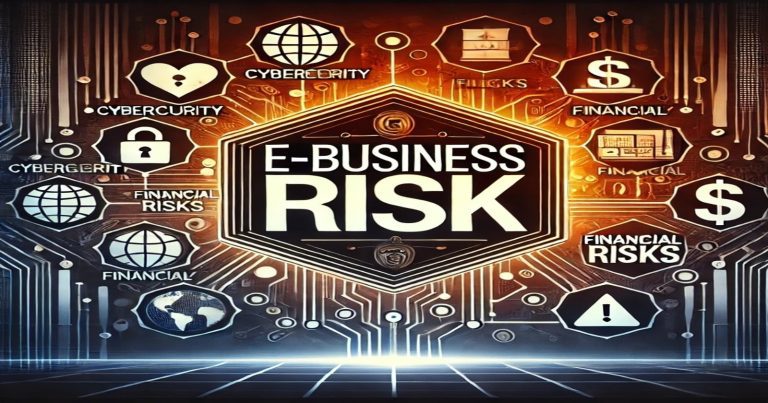E business has revolutionized commerce, allowing companies to do business easily across borders and time zones. However, this digital transformation comes with challenges collectively known as E business Risk. These risks arise from reliance on digital systems and the global nature of e-business, encompassing cybersecurity threats, legal liabilities, and operational disruptions. Understanding and managing these risks are core to businesses looking to thrive in a digital-first world.
Meaning of E Business Risk
E-business risk is the potential challenges and vulnerabilities that businesses face in online operations. The risks include threats to data security, operational continuity, legal compliance, and customer trust. Organizations need to identify and address these risks proactively to ensure smooth and secure e-business operations. With the rise of cyber threats, e-business risk has become a central focus for digital enterprises.
Types of E Business Risk
E business risks encompass various challenges that businesses face in the digital environment. These risks, ranging from cybersecurity threats to legal and operational issues, can significantly impact online operations and customer trust if not managed effectively. Understanding the different e-business risks can be addressed well. These are:
Cybersecurity Risks
These consist of data breaches, hacking, phishing, and malware attacks that can compromise confidential information and halt operations.
Example: Illegal access to a customer’s information may lead to reputational and financial losses.
Legal and Regulatory Risks
E-businesses face legal and regulatory risks in areas such as the protection of data, tax laws, and industry-specific regulations. Failing to observe these regulations incurs penalties.
Example: Failure to comply with GDPR could result in high penalties for data breach of customer information.
Operational Risks
Operational risks refer to system failure, software crashes, and disruption of the supply chain that threatens e-business continuity.
Example: The crash of a website during sales can lead to the loss of considerable revenue.
Fraud Risks
Online transaction fraud may be related to identity theft or chargebacks.
Example: Fraudulent credit card transactions can lead to loss of trust and increased operational costs.
Reputational Risks
Negative online reviews, social media backlash, or data breaches can damage a company’s reputation.
Example: A security breach posted on social media can scare away customers.
Various E-Business Risk Management Issues
E-business risk management deals with issues such as:
- Risk Identification: Identifying potential vulnerabilities in systems and processes.
- Threat Monitoring: Ongoing monitoring of new and emerging threats.
- Compliance Issues: Conforming to fluctuating regulatory obligations.
- Technological Hurdles: Competing with swift technological changes, which may threaten the existence of outdated systems.
- Fluctuating Risk Environment: Mitigating continuously changing cyber threats.
- Geographic Compliance: Conforming to various legal systems in different places.
- Resource Restriction: Securing sufficient resources to mitigate identified risks.
- Absorption of Novel Technology: Balancing new technological changes with safety measures.
How to Mitigate E Business Risk?
There should be a balanced and structured approach integrating technology, policy, and training to mitigate the risk involved with e-business. Businesses have to take active measures to secure their digital ventures and customer confidence.
Action Measures
- Install and implement strong Cybersecurity
- Install firewall
- Set up antivirus programs
- Ensure regular updations and patches in the systems
- Ensure the encryption of confidential data from any unauthorized access.
Compliance Framework
- Regular audits of compliance with the law and regulation.
- Train employees on requirements for compliance.
- Use consultants for legal advice in handling complex regulations.
Business Continuity Plans
- Implement disaster recovery.
- Back up critical data and systems.
- Test recovery through simulation.
Customer Authentication
- Implement MFA for user accounts.
- Use advanced fraud detection tools.
- Monitor transactions for suspicious activity.
Invest in Employee Training
- Train staff on recognizing phishing attempts and cybersecurity threats.
- Foster a culture of vigilance and accountability.
E Business Risk FAQs
What is E-business Risk?
E-business risk encompasses challenges of running a business online, such as cybersecurity threats, operational disruptions, and legal compliance issues.
Why is managing E-business Risk important?
Managing e-business risk protects businesses from financial loss, legal penalties, and reputational harm, ensuring continuity and customer trust.
How can businesses mitigate cybersecurity risks?
Cybersecurity can be reduced by various firewalls, encryption of data, and multi-factor authentication to safeguard online business.
What are the operational risks in E-business?
Operational risks are system shutdowns, failure of software, and disturbance in the supply chain which affects the business continuity of any online business.
How does compliance impact E-business operations?
Compliance dictates that a company follows the appropriate legal and regulatory procedures in its business, thus preventing penalties and safeguarding customer loyalty.


